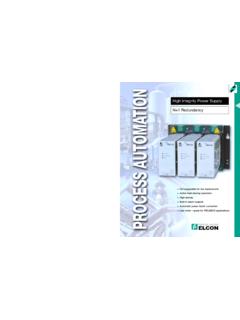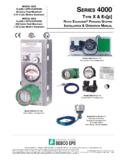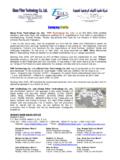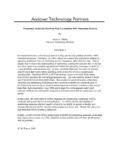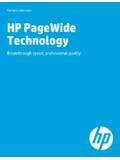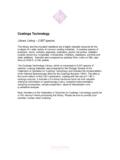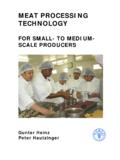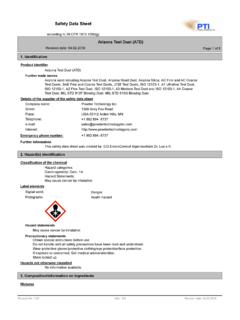Transcription of Pepperl+Fuchs, Inc. — Purge/Pressurization Systems ...
1 T1 INTRODUCTIONThe Leaders in Purging TechnologyTM +Fuchs, Inc. Purge/Pressurization Systems technology ReviewHandbook Contents The need to place general purpose equipment in hazardous (classifi ed) locations is not new, yet in the last three decades the need has intensifi ed dramatically. This is primarily due to the following facts: Process control, measuring and recording equipment that was once primarily pneumatic is now primarily general purpose electronic equipment. Motors and switchgear now use electronic accessories to satisfy the needs for position, speed or process control and energy effi ciency, which often renders the equipment unsuitable for use in hazardous locations. Newly developed equipment, such as robotic manipulators, CNCs, batch weigh/count and fi lling Systems , analyzers, programmable controllers and CRT work stations are rapidly becoming more prevalent in the industrial work environment.
2 While the demand for these new devices continues to grow, most of them cannot be economically installed in a hazardous location by using explosion proof enclosures or intrinsic safety barriers, alone. Most modern electronic equipment is expensive and delicate. For this reason, it requires environmental protection that cannot be provided by explosion proof enclosures or intrinsic safety barriers. Therefore, the need for an alternative to explosion proof enclosures and intrinsic safety barriers has become extremely alternative is purge and pressurization . As you learn more about it will become apparent that this technology is exactly what you require. It will then become obvious that this technology offers the safest and most economical means of installing electrical equipment in a hazardous location. In addition, this technology will undoubtedly impress you as the only defi nitive way to enhance your equipment's performance and access, while increasing the life expectancy of delicate instruments.
3 Finally, you'll learn the most important point of all:The answer to your need is Pepperl+Fuchs Bebco Pepperl+Fuchs Bebco Rapid ExchangeTM Purging system and several accessories make this enclosure acceptable for Class I, Group C & D, Division 2 hazardous MSA Monitor is protected with a Pepperl+Fuchs Bebco Model 1001A Type "Z" Purging system making it suitable for Class I, Group A-D, Division 2 hazardous ning the Need INTRODUCTIONDefi ning the Need Page T1 Examining the Solutions Page T2 STUDY GUIDEDefi ning Hazardous Areas Page T4 Common Questions Page T5 NFPA & ISA Design Standards Page T6 pressurization system Designs Page T7 DESIGN GUIDET ypical Enclosure Connections Page T8 Indicators, Alarms & Cutoffs Page T9 Enclosure Marking & Wiring Page T10 Basic Operating Procedures Page T11 APPLICATION GUIDEE nclosure Design Considerations Page T12 Device Use Considerations Pages T13 - T14 Typical Applications Pages T15 - T16T2 INTRODUCTIONThe Leaders in Purging TechnologyTM +Fuchs, Inc.
4 Purge/Pressurization Systems technology ReviewExamining the SolutionsExplosion Proof Enclosures Intent These enclosures are designed to contain an explosion if an electrical device ignites fl ammable substances within the enclosure, thus preventing ignition of the surrounding atmosphere. These enclosures are commonly used for circuit breakers, mechanical switchgears and high-powered equipment. The failure to properly tighten all bolts and screw covers on these enclosures is the greatest problem facing end Explosion Containment No Electronics Requires Low Maintenance No Moving Parts High-Powered EquipmentDisadvantages Cannot Indicate Failure of Containment Capability Danger to Equipment After Explosions Possibility of Installation/Maintenance Errors Cost of Protection per ft3 Increases With Enclosure Size Windows are Limited Promotes Condensation Limited Sizes Cumbersome, Limited Access Bulky Designs Causes Harmful Heat Build up Excessive WeightIntent These devices are designed to limit the current and voltage conducted through a device's power or signal wiring.
5 This limitation prevents shorting and arcing of the wires or device, thus preventing ignition of the surrounding atmosphere. They are commonly used for protection of instruments that operate at extremely low power levels and are suitable for exposure to the environment. Advantages The Only Protection Allowed for Zone 0 Eliminates Possibility of Explosion No Hot Permits Requires Low Maintenance No Special Cables Ideal for Low-Power Devices Limits Energy to DeviceDisadvantages Requires Documentation of Circuits and Installation Can be Used Only With Low-Power DevicesIntrinsic Safety BarriersT3 INTRODUCTIONThe Leaders in Purging TechnologyTM +Fuchs, Inc. Purge/Pressurization Systems technology ReviewAdvantages Reduces Heat Build up Inhibits Metal Corrosion Requires Low Maintenance Increases Equipment Longevity No Special Enclosures Required Allows Fast Access to Equipment Reduces Moisture & Dust Build up Reduces Classifi cation Within the Enclosure Continuous system Status Indication Protects Enclosures up to 450 ft3 Allows use of any Enclosure Shape Cost of Protection per ft3 Decreases With Enclosure SizeDisadvantages Contains Moving Parts Requires Instrument Air Supply Some Systems Require Electronics Hot Permits Required Pepperl+Fuchs Bebco EPSP urge and pressurization is the only technology that meets the demand for general purpose equipment with standard enclosures inside hazardous locations Intent Pepperl+Fuchs Bebco EPS Division Products are designed to supply one or more
6 Protected enclosures with a clean instrument air or inert gas. This process removes fl ammable gases or prevents the accumulation of ignitable dusts within the protected enclosure(s). This method of protection is not limited by the quantity, confi guration, power requirements, or location of the protected equipment. These Systems are commonly used for all applications involving basic electronics, electrical equipment, motors and switchgear. In addition these Systems can also meet the demands of rack mounted instrumentation, video displays, programmable controllers, computers, printers, recorders, measurement, gas analyzers and calibration equipment. One of the best benefi ts is the slow but continuous fl ow of protective gas, which can be specifi cally used to eliminate problems like heat, moisture, dust and corrosion. And unlike explosion proof enclosures, failure of a Pepperl+Fuchs Bebco Enclosure Protection system does not create an immediate Protection SystemsThe Leaders in Purging TechnologyTM GUIDEP epperl+Fuchs, Inc.
7 Purge/Pressurization Systems technology ReviewDefi ning Hazardous AreasHazardous Area Defi nition Hazardous (classifi ed) locations are those areas in an industrial complex where the atmosphere contains fl ammable concentrations of gases or vapors by leakage, or ignitable concentrations of dusts or fi bers by suspension or National Fire Protection Association The National Fire Protection Association (NFPA), formed in 1896, is a nonprofi t organization devoted to fi re safety standards and codes. It currently retains over 40,000 members who work to determine safe practices and establish standards for all areas of commercial, industrial and residential construction. They publish many documents including NFPA 70 - better known as the National Electric Code and NFPA 496 - the document that specifi es recommended practices for pressurization and Classifi cation Methods The NFPA establishes area classifi cations using three factors.
8 Identifi ed as Classes, Groups and Divisions, these factors are combined to defi ne conditions of specifi c areas. Classes are used to defi ne the explosive or ignitable substances that are present in the I - Flammable gases or liquid vaporsClass II - Ignitable metal, carbon or organic dustsClass III - Ignitable fi brous materialsDivisions are used to defi ne the degree of hazard by determining the explosive or ignitable substance's expected concentration in the 1 - Contains substances under normal conditionsDivision 2 - Contains substances under abnormal conditionsImportant Notes:Division 1 areas must be surrounded by Division 2 are used to defi ne substances by rating their explosive or ignitable nature, in relation to other known substances.
9 TYPICAL CLASS I SUBSTANCESG roup A - Acetylene Group B - Hydrogen or > 30% Hydrogen by VolumeGroup C - Ethyl Ether & EthyleneGroup D - Acetone, Ammonia, Benzene & GasolineTYPICAL CLASS II SUBSTANCESG roup E - Aluminum, Magnesium & AlloysGroup F - Carbon, Coke & CoalGroup G - Flour, Grain, Wood, Plastic & Chemicals Zones are used to defi ne the degree of hazard by determining the explosive or ignitable substance's expected concentration in the 0 - Contains substances under normal conditions (Continuously)Zone 1 - Contains substances under normal conditions (Intermittently)Zone 2 - Contains substances under abnormal conditionsToday's modern refi neries and manufacturing complexes often contain both fl ammable gases and ignitable dusts, making area classifi cation of Division 1 and Division 2 locations an important but tricky RatingsGroup RatingsDivision RatingsZone RatingsT5 The Leaders in Purging TechnologyTM GUIDEP epperl+Fuchs, Inc.
10 Purge/Pressurization Systems technology ReviewHow can the equipment be accessed? Equipment mounted in the protected enclosure can be accessed if the area is known to be nonhazardous, or if all power to the protected equipment has been de-energized. In other words, internal equipment should be treated as if located in an explosion proof enclosure. However, a cooling period may be required before accessing hot components, such as transformers or variable speed drives, which would otherwise be unacceptable for use in the hazardous location. Equipment mounted through the surface of a protected enclosure may require a sealed access door if the equipment is not suitable for exposure to the surrounding atmosphere. Advanced pressurization Systems , like Pepperl+Fuchs Bebco Rapid ExchangeTM Purging Systems can maintain a positive pressure, by increasing the fl ow of protective gas while the access door is is purging?
